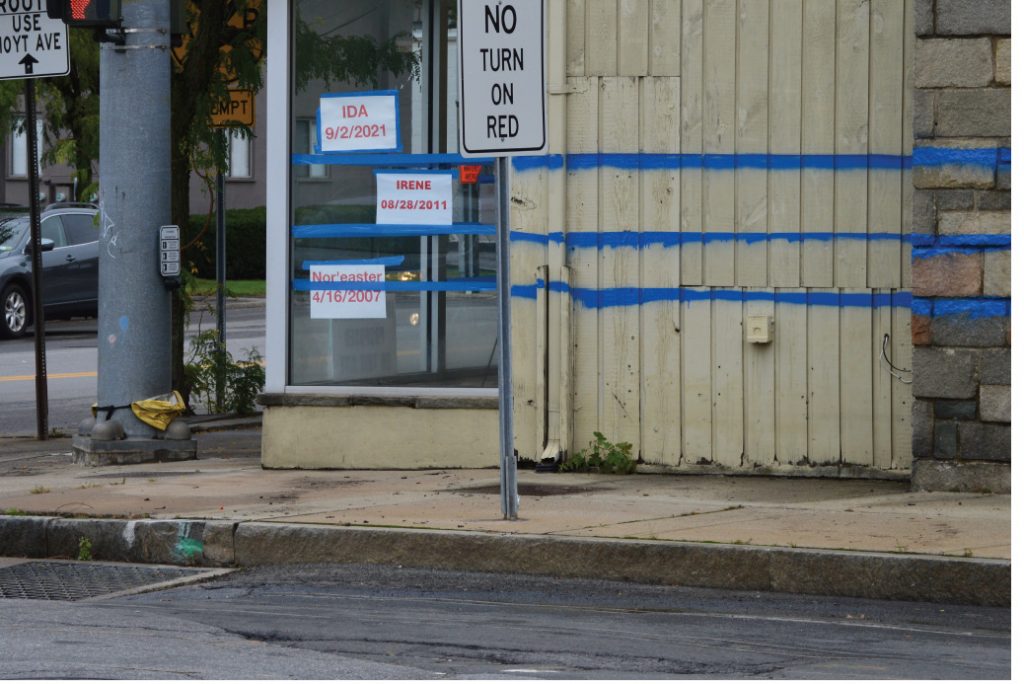On a corner storefront in the Village of Mamaroneck, NY, about a block from where the Sheldrake River turns away from I-95, the exterior wall is wrapped with three horizontal blue stripes in paint and painter’s tape.
The lowest, several feet above street level, is marked by red print on a white sign: Nor’easter, 4/16/2007. It’s the height the floodwaters reached during a rare spring storm that broke rainfall records throughout the region and required hundreds of Mamaroneck residents to evacuate their homes.
The next line, a foot or so higher, reads “IRENE, 08/28/2011,” the hurricane that delivered its own record-breaking rain, which preceded Superstorm Sandy by a little more than a year. The topmost line, unthinkably high when you realize what it represents, is the big one: “IDA, 9/2/2021.” The rainfall in Ida was historic. Between 8:50 and 9:50 p.m. on September 1, 2021, 3.15 inches of rain fell in Central Park – New York City’s wettest hour, exceeding the 1.94 inches dumped in an hour by Hurricane Henri just 11 days before. Meanwhile, flood waters in Mamaroneck, according to some reports, rose as high as 14 feet.
Reports of rainfall records are starting to sound like a broken record. “It’s the unnamed rain events – they’re just rain events now – creating situations that threaten our homes and business,” said Westchester County legislator Catherine Parker.

Is Westchester County ready for another record-breaking rainfall? ©SavetheSound.org
One of those unnamed rain events hit the Long Island Sound region on September 29, dumping more than half a foot of rain in Westchester County, on Long Island, and across New York City (including 8+ inches at John F. Kennedy Airport, another single-day record rewritten). That Storm with No Name, just a week after the region braced for Tropical Storm Ophelia, resulted in the now-familiar news of states of emergency issued, highways underwater, service suspended on subways, and flights delayed (LaGuardia’s Terminal A flooded and was closed for most of the day). In Queens, a baseball game was rained out, which is not unusual, but a preseason hockey game was cancelled– and those are played indoors! It simply wasn’t possible to travel to the arena. That end-of-the-month deluge gave New York City its wettest September in 150 years. It was the third-wettest in Connecticut, coming on the heels of the wettest July recorded in the Greater Hartford area.
Even storms that weren’t destructive were strong enough to disrupt summertime activities. Beach closures were rampant. As the sailing community knows, regattas were canceled or postponed due to storms, or the competition was impacted.
“We had some really unusual weather patterns in September and October,” said Libby Alexander, a longtime sailor, Westchester County resident and former board member of Save the Sound. “It felt very unusual to have that many days straight of heavy rain.” The parking lots and docks she launches from are starting to be impacted by sea level rise and storm flooding, she added.
As month after month in New York and Connecticut challenge record rainfalls and rising temperatures, so does the need for a proportionate response. Which is why steps taken during those first bright, sunny, dry days of October felt particularly timely.
On Monday, October 2, the Westchester County Board of Legislators approved significant investments in stormwater management and flood mitigation. The next day, New York State Senator Shelley Mayer and Assemblyman Steve Otis gathered with local municipal leaders, environmental groups (David Ansel, our vice president of water protection, among them), and the Department of Environmental Conservation to celebrate Governor Kathy Hochul signing their Living Shorelines Act into law.
“Save the Sound,” said Senator Mayer, “originally educated me about the necessity of a bill to change the presumption in favor of this much smarter approach.”
It was shortly after Ida when Senator Mayer and Assemblyman Otis, Mamaroneck’s two representatives in the New York State legislature, initially conferred with Save the Sound about potential legislative solutions. This “much smarter approach,” now law in New York State, empowers the DEC to prioritize green infrastructure over gray in protecting New York’s coastline from flooding and erosion.
“Due to climate change, the frequency and severity of storms, floods, coastal erosion and storm surge are all accelerating at a dangerous pace, which is putting our property and our people and our communities at risk,” said Ansel. “We know that marshes, tidal wetlands, shellfish reefs, and other nature-based solutions are more resilient and will grow and do a better job than hardened surfaces like seawalls.”
Strengthening resiliency policy and investing in infrastructure are critical in preparing communities for the inevitable next storm, named or unnamed.
“Climate change is here,” Legislator Catherine Parker said at the Living Shorelines event. “And if you talk to many people in the Village of Mamaroneck, they will tell you that climate catastrophe is here. We have to do everything in our power, through actions big and small.” To learn more, visit SavetheSound.org. ■
